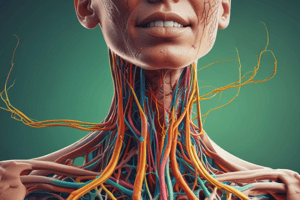Podcast
Questions and Answers
What is the primary function of the spleen?
What is the primary function of the spleen?
- To filter lymph and remove debris
- To produce lymphocytes
- To filter blood and remove debris (correct)
- To store platelets and RBCs
What is the role of Peyer's patches in the lymphatic system?
What is the role of Peyer's patches in the lymphatic system?
- To act as a sentinel to protect the digestive tract (correct)
- To act as a sentinel to protect the respiratory tract
- To filter blood and remove debris
- To produce lymphocytes
What is the function of the medulla in a lymph node?
What is the function of the medulla in a lymph node?
- To produce antibodies
- To filter lymph and remove debris
- To contain follicles with lymphocytes
- To contain phagocytic macrophages (correct)
What is the function of the cortex in a lymph node?
What is the function of the cortex in a lymph node?
What happens to the flow of lymph through a lymph node?
What happens to the flow of lymph through a lymph node?
What can happen to lymph nodes when large amounts of bacteria or viruses are present?
What can happen to lymph nodes when large amounts of bacteria or viruses are present?
What is the role of the spleen in relation to red blood cells?
What is the role of the spleen in relation to red blood cells?
What type of lymphoid tissue is the spleen?
What type of lymphoid tissue is the spleen?
What is the main function of tonsils?
What is the main function of tonsils?
What is the function of macrophages in Peyer's patches?
What is the function of macrophages in Peyer's patches?
At what stage of life does the thymus function at its peak levels?
At what stage of life does the thymus function at its peak levels?
What is lymphopoiesis?
What is lymphopoiesis?
What is the role of thymosin?
What is the role of thymosin?
What percentage of circulating leukocytes are lymphocytes?
What percentage of circulating leukocytes are lymphocytes?
What are the three classes of lymphocytes?
What are the three classes of lymphocytes?
What happens to T cells after they mature in the thymus?
What happens to T cells after they mature in the thymus?
What is the main function of the lymphatic system?
What is the main function of the lymphatic system?
What happens to the interstitial fluid that remains behind in the tissue spaces?
What happens to the interstitial fluid that remains behind in the tissue spaces?
What is the characteristic of lymphatic capillaries that allows them to push fluid only towards the heart?
What is the characteristic of lymphatic capillaries that allows them to push fluid only towards the heart?
What is the mechanism by which lymph flows towards the heart?
What is the mechanism by which lymph flows towards the heart?
What is the characteristic of larger lymphatic vessels?
What is the characteristic of larger lymphatic vessels?
What is the function of lymph nodes?
What is the function of lymph nodes?
What is the term for the fluid carried by lymphatic vessels?
What is the term for the fluid carried by lymphatic vessels?
What is the difference between lymphatic vessels and blood vessels?
What is the difference between lymphatic vessels and blood vessels?
What is the consequence of edema?
What is the consequence of edema?
What is the function of the lymphatic system in body defense?
What is the function of the lymphatic system in body defense?
Flashcards are hidden until you start studying
Study Notes
Lymph Node Structure
- Lymph nodes are kidney-shaped and less than 1 inch long, buried in connective tissue
- The cortex is the outer part of the lymph node, containing follicles with collections of lymphocytes
- The medulla is the inner part of the lymph node, containing phagocytic macrophages
Flow of Lymph Through Nodes
- Lymph flows through afferent lymphatic vessels, then sinuses inside the node, and finally efferent lymphatic vessels
- There are fewer efferent than afferent vessels, slowing the flow of lymph
- Lymph nodes can become inflamed and tender to touch if large amounts of bacteria or viruses become trapped
MALT (Mucosa-Associated Lymphoid Tissue)
- Includes Peyer's patches, tonsils, and other small accumulations of lymphoid tissue
- Acts as a sentinel to protect respiratory and digestive tracts
Other Lymphoid Organs
- Spleen:
- Filters blood rather than lymph
- Destroys bacteria, viruses, and other debris
- Destroys worn out RBCs and recycles some products, including iron
- Stores platelets and RBCs, which can be released during hemorrhage
- Can be removed, but increases the risk of infection
- Tonsils:
- Small masses of lymphoid tissue around the pharynx
- Trap and remove bacteria and other foreign materials
- Peyer's patches:
- Found in the wall of the small intestine
- Resemble tonsils in structure
- Macrophages capture and destroy bacteria in the intestine
- Thymus:
- Located in the upper mediastinum thoracic cavity
- Functions at peak levels only during childhood, shrinking by puberty
- Site of T-cell maturation
- Secretes thymosin
Lymphopoiesis
- Lymphopoiesis is the production of lymphocytes
- Involves red bone marrow, thymus, and peripheral lymphoid tissues
- Thymosin stimulates maturation of T cells, which reenter the bloodstream when near mature and travel to red bone marrow and peripheral tissues
Lymphocytes
- Account for 20-40% of circulating leukocytes
- Circulating lymphocytes are a small fraction of the total lymphocyte population
- There are three classes of lymphocytes: T cells, B cells, and NK cells
The Immune System
- Consists of two semi-independent parts: lymphatic vessels and lymphoid tissues and organs
- Lymphatic system functions: transports escaped fluids back to the blood and plays essential roles in body defense and resistance to disease
Studying That Suits You
Use AI to generate personalized quizzes and flashcards to suit your learning preferences.




